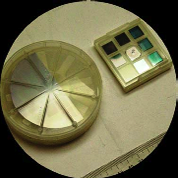APPLICATIONS OF TECHNOLOGY:

A prototype binary pseudo-random grating test surface is etched into a silicon substrate using a conventional lithographical process.
- Testing of surface profilometers
- Calibrates modulation transfer function (MTF) of microscopes
- Direct 2D calibration of instrumental MTF
- Can be used to test interferometric, atomic force and scanning probe microscopes, as well as optical, extreme ultraviolet and x-ray scatterometers
- Potentially applicable to digital imaging, photogrammetry
ADVANTAGES:
- Uniform sensitivity to measurement of the MTF function at all desired frequencies
- Provides a measure of the system MTF averaged over the entire linear extent of the field of view, not just in a localized region
- Mathematically deterministic
- Test surface is easily mass manufactured
- Convenient for microfabrication, can be adapted for nanofabrication
ABSTRACT:
Power spectral density (PSD) characterization of surface height distributions is widely used for the most rigorous metrology of a variety of surface profilometers. This improves upon the conventional statistical characterization based on a single parameter, roughness. The task of designing high-performance x-ray optical systems requires the development of sophisticated x-ray scattering calculations based on rigorous information about the optics. One of the most productive approaches to these calculations is based on the PSD distribution calculated from the array of surface heights. A major problem measuring PSD distributions with an interferometric and/or atomic force microscope arises because the Modulation Transfer Function (MTF) of the instruments is not known and must be experimentally determined. The MTF characterizes the perturbation of the PSD distribution at higher spatial frequencies.
Lawrence Berkeley National Laboratory scientists Valeriy Yashchuk and Wayne McKinney, in collaboration with Peter Takacs from Brookhaven National Laboratory, have devised a new method and dedicated test surfaces for calibration of the MTF of a microscope, based on the use of specially designed Binary Pseudo-Random (BPR) gratings and arrays.
Comparison of a theoretically calculated PSD spectrum of a BPR grating with a spectrum measured with the grating provides the desired calibration of the instrumental MTF. The term “pseudo-random” implies that the distribution is specially generated to possess a property of randomness in the mathematically strong sense. The distribution, which appears random but is in fact the result of a deterministic calculation, lends itself well to the calibration of particular instruments.
STATUS:
-
Published US Patent Application # 12/408,508 available www.uspto.gov. Available for licensing or collaborative research.
To learn more about licensing a technology from LBNL see http://www.lbl.gov/Tech-Transfer/licensing/index.html.
FOR MORE INFORMATION:
REFERENCE NUMBER: IB- 2499
SEE THESE OTHER BERKELEY LAB TECHNOLOGIES IN THIS FIELD: